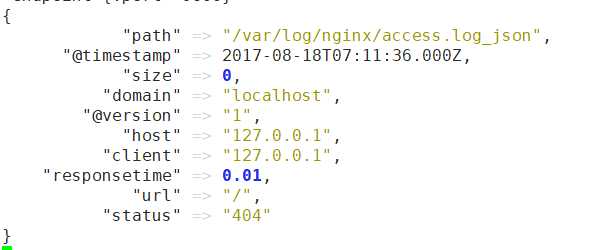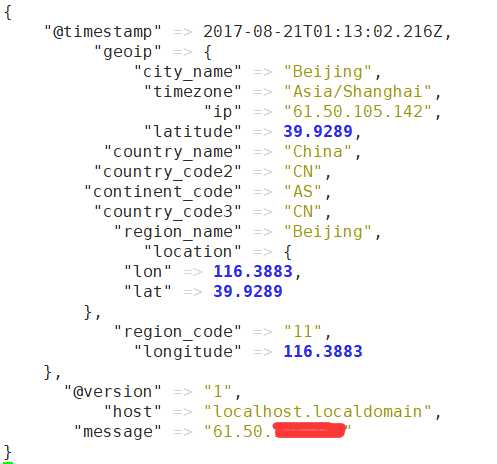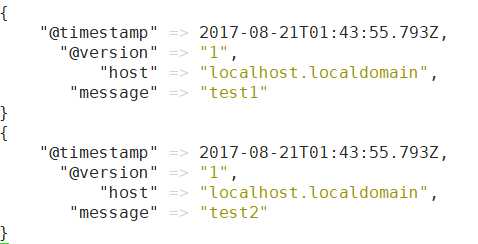标签:strong 事件 smtp mapping field pid stash pre start
logstash使用一个名为 filewatch的 ruby gem库来监听文件变化, 这个库记录一个 .sincedb的数据文件跟踪监听日志文件的当前位置
input { file { path => ["/var/log/*.log", "/var/log/message"] type => "system" start_position => "beginning" } }
output {
stdout{
codec=>rubydebug
}
}
其他配置
discover_interval: 每隔多久检查path下是否有新文件, 默认15s
exclude: 不行呗监听的文件排除
close_older: 被监听的文件多久没更新就关闭监听, 默认3600s
ignore_older: 检查文件列表时, 如果最后修改时间超过这个值, 就虎烈
logstash最简单最基本的输入方式
在 {LH}/下, 新建 stdin.conf, 并输入以下内容:
input{ stdin{ add_field=>{"key"=>"value"} codec=>"plain" tags=>["add"] type=>"std" } } output { stdout{ codec=>rubydebug } }
使用命令运行
./bin/logstash -f ./stdin.conf
启动后输入 helloworld, 可以看到如下输出
这儿的 type 和tags 是logstash的两个特俗字段, 通常会在输入区域通过type标记事件类型, tags则在数据处理阶段, 由具体的插件来添加或删除的
从设备上收集日志的时候可用
input { syslog { port => "514" } }
output {
stdout{
codec=>rubydebug
}
}
此时, 系统的日志都会到logstash中来, 建议使用使用LogStash::Inputs::TCP和 LogStash::Filters::Grok 配合实现同样的 syslog 功能! 具体可见: https://kibana.logstash.es/content/logstash/plugins/input/syslog.html
input { tcp { port => "8514" } } filter { grok { match => ["message", "%{SYSLOGLINE}" ] } syslog_pri { } }
可被redis,等替代作为 logstash broker 的角色, 但logstash又自己的tcp插件
input { tcp { port => 8888 mode => "server" ssl_enable => false } }
最佳使用是: 配合 nc 命令导入就数据
# nc 127.0.0.1 8888 < olddata
导入完毕后, nc命令会结束, 如果使用file会一直监听新数据
使用codec可以处理不同类型的数据, 使得logstash 形成 input | decode | filter | encode | output 的数据流, codec就是用来 encode 和 decode的
将nginx的日志导入为json格式: nginx需要配置 conf, 在 http{} 下进行配置, 所有server共享
logformat json ‘{"@timestamp":"$time_iso8601",‘ ‘"@version":"1",‘ ‘"host":"$server_addr",‘ ‘"client":"$remote_addr",‘ ‘"size":$body_bytes_sent,‘ ‘"responsetime":$request_time,‘ ‘"domain":"$host",‘ ‘"url":"$uri",‘ ‘"status":"$status"}‘; access_log /var/log/nginx/access.log_json json;
修改stdin.conf
input { file { path => "/var/log/nginx/access.log_json" codec => "json" } }
然后访问本地nginx, 可以看到logstash输出:

一个事件打印多行内容, 很难通过命令行解析分析, 因此需要:
input { stdin { codec => multiline { pattern => "^\[" negate => true what => "previous" } } }
将当前的数据添加到下一行后面, 知道新匹配 ^[ 位置
扩展了进入过滤器的原始数据,进行复杂的逻辑处理,甚至可以无中生有的添加新的 logstash 事件到后续的流程中去!
logstash内部使用了java的 joda 时间库来处理时间
filter { grok { match => ["message", "%{HTTPDATE:logdate}"] } date { match => ["logdate", "dd/MMM/yyyy:HH:mm:ss Z"] } }
可以将输入的文本匹配到字段中去:
input {stdin{}} filter { grok { match => { "message" => "\s+(?<request_time>\d+(?:\.\d+)?)\s+" } } } output {stdout{codec => rubydebug}}
然后输入 begin 123.456 end

grok支持预定义的grok表达式:
%{PATTERN_NAME:capture_name:data_type}所以上例可改成:
filter { grok { match => { "message" => "%{WORD} %{NUMBER:request_time:float} %{WORD}" } } }
重新运行后, request_time的值变为float类型的,
实际使用中: 建议把所有的fork表达式统一写在一个地方, 然后patterns_dir指明. 如果将message中的所有信息都grok到不通字段了, 数据就存储重复了, 因此可以用remove_filed或者 overwrite来重写message
filter { grok { patterns_dir => ["/path/to/your/own/patterns"] match => { "message" => "%{SYSLOGBASE} %{DATA:message}" } overwrite => ["message"] } }
跟grok类似, 但资源消耗较小. 当日志格式有比较简明的分隔标志位,而且重复性较大的时候,我们可以使用 dissect 插件更快的完成解析工作
filter { dissect { mapping => { "message" => "%{ts} %{+ts} %{+ts} %{src} %{} %{prog}[%{pid}]: %{msg}" } convert_datatype => { pid => "int" } } }
比如配置: http://rizhiyi.com/index.do?id=123
http://%{domain}/%{?url}?%{?arg1}=%{&arg1} 匹配后 { domain => "rizhiyi.com", id => "123" }
解释
%{+key} 这个 + 表示,前面已经捕获到一个 key 字段了,而这次捕获的内容,自动添补到之前 key 字段内容的后面。
%{+key/2} 这个 /2 表示,在有多次捕获内容都填到 key 字段里的时候,拼接字符串的顺序谁前谁后。/2 表示排第 2 位。
%{?string} 这个 ? 表示,这块只是一个占位,并不会实际生成捕获字段存到 Event 里面。
%{?string} %{&string} 当同样捕获名称都是 string,但是一个 ? 一个 & 的时候,表示这是一个键值对。
input {stdin{}} filter { geoip { source => "message" } } output {stdout{codec => rubydebug}}
运行结果

如果只想要其中某些字段, 可以通过fileds来指定
geoip { fields => ["city_name", "continent_code", "country_code2", "country_code3", "country_name", "dma_code", "ip", "latitude", "longitude", "postal_code", "region_name", "timezone"] }
最近一分钟 504 请求的个数超过 100 个就报警:
filter {
metrics {
timer => {"rt" => "%{request_time}"}
percentiles => [25, 75]
add_tag => "percentile"
}
if "percentile" in [tags] {
ruby {
code => "l=event.get(‘[rt][p75]‘)-event.get(‘[rt][p25]‘);event.set(‘[rt][low]‘, event.get(‘[rt][p25]‘)-l);event.set(‘[rt][high]‘,event.get(‘[rt][p75]‘)+l)"
}
}
}
output {
if "percentile" in [tags] and ([rt][last] > [rt][high] or [rt][last] < [rt][low]) {
exec {
command => "echo \"Anomaly: %{[rt][last]}\""
}
}
}
可转换的类型包括 integer, float, string
filter { mutate { convert => ["request_time", "float"] } }
字符串处理: , sub
gsub => ["urlparams", "[\\?#]", "_"]
split:
filter { mutate { split => ["message", "|"] } }
join, 将split切分的在join回去
filter { mutate { split => ["message", "|"] } mutate { join => ["message", ","] } }
rename: 字段重命名:
filter { mutate { rename => ["syslog_host", "host"] } }
是multiline插件的反向, 将一行数据切分到多个事件中去
filter { split { field => "message" terminator => "#" } }
然后输入 "test1#test2", 可以看到被输出到2个事件中

output { stdout { codec => rubydebug workers => 2 } }
output { elasticsearch { hosts => ["192.168.0.2:9200"] index => "logstash-%{type}-%{+YYYY.MM.dd}" document_type => "%{type}" flush_size => 20000 idle_flush_time => 10 sniffing => true template_overwrite => true } }
注意索引名中不能有大写字母,否则 ES 在日志中会报 InvalidIndexNameException,但是 Logstash 不会报错,这个错误比较隐晦,也容易掉进这个坑中。
3), email
126邮箱发送到 qq邮箱的示例
output { email { port => "25" address => "smtp.126.com" username => "test@126.com" password => "" authentication => "plain" use_tls => true from => "test@126.com" subject => "Warning: %{title}" to => "test@qq.com" via => "smtp" body => "%{message}" } }
标签:strong 事件 smtp mapping field pid stash pre start
原文地址:http://www.cnblogs.com/wenbronk/p/7392305.html